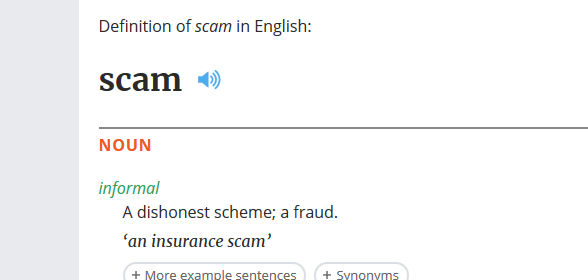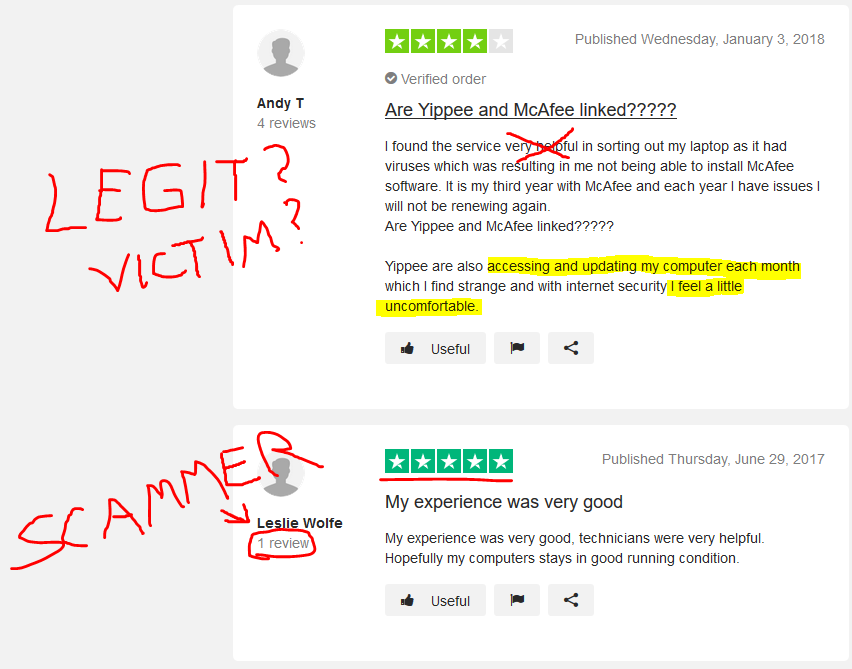insert_linkScams. What Are They?
In order to be able to spot a scam, you must first be able to identify what a scam is. Therefore, as always, let us refer to the good-old Oxford Dictionaries definition:

As you can clearly see, the term “scam” could cover an exceedingly wide range of activities. And rightly so, too, since scams can range from medical doughnuts to Nigerian princes. In this article, however, I’m going to focus on the phishing attempts that you might encounter as a technological user.
Even so, narrowing down to a specific category of scams, it’s not difficult to spot a scam. That is, if you look around hard enough, or perhaps by not even trying at all to spot a scam.
[caption id="" align="alignright" width="425"] Don't be so quick to pop out your wallet.[/caption]
Don't be so quick to pop out your wallet.[/caption]
This merely emphasises the problem that is scamming; if it is little trouble to spot a scam, they are evidently far more widespread than we would like. This is a terrible thing, as it indicates millions of undeserving victims having their personal information and/or finances shamelessly “repossessed”.
An honest living does not consist of cheating and avoiding the purposeful challenges of life.
insert_linkHere to End Scams
But you are here to avoid the stomach-sinking sensation of losing your children to the bad man (or woman). Well, help is at hand, for the reason that you can learn to spot a scam: you can develop the correct mindset when approaching situations amidst the shady shadows of the Internet—the questionable online world.
Never be swayed by the winds of an online scamming attempt. Rather, spot the scam before it’s too late, by simply listening (with your eyes, obviously) to 3 straightforward words.
Also, there is a substantial potential severity—as well as lethality—of scams of all kinds. For this reason, these words regarding this unfortunately-existing topic must not go through one eye and out the other.
insert_linkThe 3 Fundamental Words to Spot a Scam
While there are, indeed, many aspects of spotting a scam, it is of paramount importance to know the ultimate key. This “key” will, in fact, be at your assistance throughout your life, not merely to spot a petty scam.
So, without any further, verbose, text on your screen, here are the legendary three words everyone needs to employ:
insert_linkAlways Be Sceptical
People lie.

After all, it is always the people who blindly accept statements as fact who find themselves in unfortunate situations. This is invariably inevitable if such behaviour is upheld.
Alas, the world hasn’t developed to the point at which we can all trust the words of others. This stands true in face of those believing their own words, not to mention, the dirty, dirty scammers.
The solution? Be faultlessly sceptical of all information that comes your way! Then again, what is the worst that could plausibly come of it?
I next will tell you the answer: you perceive a true fact as the polar opposite, which is an utter lie, or total mistruth. Moreover, what are the implications of that situation?
Indeed, that piece of information could have perhaps been of significant importance. However, I can tell you that you didn’t lose any information or money as a direct result of your action.
That being said, an overdosage of scepticism could equally lead to unwanted consequences such as those experienced in phishing attempts. Nevertheless, the standing truth is that an excess of scepticism is safer than a surplus of certitude in unexpected situations.
Thus, you should never fall for the blunder of blindly accepting all information which you are told as true. This is the key factor if you’re ever going to spot a scam.
Equally, it would be wise to approach situations with open-minded scepticism. To clarify, this is not me contradicting myself; it is always perfectly possible to be sceptical and open-minded simultaneously.
This entails being open to the idea that something may be legitimate, meanwhile searching for the red scam flags.
Next, let us explore the various scams you might come across, as well as how to spot a scam.

insert_linkHow to Spot a Scam: What to Look Out For
All scams have some common defining features that you can look for to spot a scam. Of course, these features vary between different scam attempts due to their varying nature.
insert_linkAn Incorrect Origin
If Microsoft—the real company—contacted you by phone, saying your computer was infected, would it really be a scam? Obviously not, though, Microsoft would never call you unexpectedly telling you that you had a problem with your computer.
Accordingly, it becomes incredibly easy to spot a scam when the origin of information is unofficial. The origin in this case, for example, would be the phone number; if the phone number is not an official one listed on the Microsoft website, it is certainly a no-go.
But there are also other sources of information, depending on the medium through which the scam is conducted. They include but are definitely not limited to:
- Email address (chiefly the domain which is all text following the “@” symbol). For instance,
[email protected]is perfectly legitimate, whereasnoreply@netflix.ssl.comshould not be trusted—where all mail should meet the junk folder. - Website address: like email addresses, you must be certain that the address is official before providing any sensitive information.
- Phone numbers, when scammers try to call you.
insert_linkBut That’s Not All
While these can give the initial indicator when trying to spot a scam, keep in mind that information can be spoofed. To exemplify, callers can easily show false phone numbers when calling you, and the same goes for emails. Therefore, the origin of the potentially ill-purposed information does not tell the entire story.
Nonetheless, website addresses can’t exactly be spoofed, so it’s effortless to spot a scam in that regard. If the company—which the potential scammer is claiming to be—matches the website address, all should theoretically be good.
[caption id="" align="aligncenter" width="713"] Barclays' tips for an anti-scam world.[/caption]
Barclays' tips for an anti-scam world.[/caption]
You can spot a scam by going to the official website of the company in question to verify the legitimacy of the information. Sometimes, the company lists all the email addresses they will contact you through.
Additionally, if you are unsure—perhaps the email address/phone number could be spoofed—contact the official company. Again, ensure that you do this via the official website which you visited on your own terms. They could subsequently confirm whether the message/call is legitimate, and they might even do something about the scam.
insert_linkAdding Common Sense to The Circumstances
Typically, scam attempts propel themselves at you at a time when it is unexpected. The key word here is unexpected, or rather, unsolicited.
Of course, legitimate companies may contact you unexpectedly but initiate the red alert when something catches you by surprise.
[caption id="" align="alignright" width="200"] Author: CarbonNYC [in SF!]
Author: CarbonNYC [in SF!]License:
 [/caption]
[/caption]
Likewise, if you are contacted by a company with services for which you have not signed up, prepare for scammers. After all, why (and how) on Earth would a legitimate company contact you regarding a service you don’t even use.
To exemplify, you could receive a call/message stating your Netflix account has been compromised. For anybody who doesn’t use Netflix, this piece of incoming information is, in any case, completely ignorable. For you see, this is merely “common sense”.
insert_linkEvaluating the Intent of The Potential Scam
Another way for you to spot a scam is by evaluating the intent of a communication. For example, make sure to look out for anything involving acquiring personal information. This can include:
- An ID of sorts
- Birth-date, home address, name, contact info, and any other personally-identifying information
- Banking details
- Money and cryptocurrency
As a rule, you must always be careful with what information you give away. Also, do you ever listen to the advice your bank probably tries to enforce upon you? Regardless, I would make it a self-enforced rule to never give out banking details over the phone or email.
In fact, you should never disclose such details over any medium unless it is official and secure. Firstly, you can look for the official website address preceded by an https://. Secondly, there should be a green padlock next to the address bar to indicate there are no security problems.
However, note that illegitimate websites may also have a good-green-looking https://.
insert_linkSanity Check: Is This Truly Realistic?
Once again, introducing the trustworthy, instinctual common sense. Ask yourself this question every time, is the scenario presented really that realistic?
For example, it’s probably a scam if some lottery winner is donating on your behalf. Furthermore, a Nigerian prince in need of funds is probably as much of a scam. Then again, how can you have confidence in an absolute stranger to pay you back with 50% interest.
In situations where you are trusting strangers when you don’t even know where they got your contact information, think again.

Moreover, the proposition is another key factor to spot a scam red-handed. Give yourself a sanity-check; is that person or company really going to give you X amount of money for virtually nothing?
Probably not, as a matter of fact.
It is things like unexpected giveaways and offers—especially those unannounced officially—that you should be concerned about. In addition, hard evidence is a necessity when verifying something requesting personal information to be legit.
If it seems too good to be true, you have probably just spotted a scam—nothing special.
insert_linkAre They Trying Too Hard to Seem Legitimate?
Ironically, you can often spot a scam which is trying too hard to not seem like a phishing attempt.
insert_linkDirect Address
Firstly, if they use your name or any other details, that does not guarantee what you’re dealing with is legitimate. This is because people can often find out some information about you using certain methods, like an online phone book.
insert_linkReviews
Secondly, reviews are frequently used as evidence for being a genuine company, although reviews don’t always tell the entire story.
One method is to include a fake review section of the scammers’ website. Moreover, this is normally populated with manufactured reviews which are almost too faultlessly positive in their feedback. Since it would otherwise seem too good to be true, there would surely be some criticisms of the product or service?

On the other hand, scammers can refer to established review websites such as Yelp or Trustpilot. Despite the legitimacy of the review service, the illegitimate companies have shockingly high ratings.
In this case, it’s either the scammers leaving fake reviews or them buying fake reviews from a dodgy service. Indeed, there are people who, with a nice, juicy payment, can give innumerable reviews on a review website.
You can look a little deeper at the negative reviews and, believe me, they will disclose the petrifying truth.
insert_linkCertifications and Approvals
Thirdly, you may find various badges or certifications ensuring satisfactory customer service, security, or approval. These, however, do not point to a definite genuine company, even if they are seemingly issued by a reputable company. This is because it is not a great challenge for those scammers to place another company’s badge on their website.
Furthermore, a website might use a surplus of a legit company’s logos to attempt to mirror that website. As ever, though, if you try to visit the official website, you can directly compare it to the suspicious website.
insert_linkAddressing Your Concerns Directly
Lastly, there could be direct justification in text or speech emphasising legitimacy in face of the too-good-to-be-true aspect. I advise you pay attention to this and evaluate whether or not it is all nonsense or fairly sensical. Although, even logical arguments can be flawed, as, for example, is that company truly that generous or in that situation?
Keep in mind that few companies feel the need to justify themselves with reviews or reasoning as to why they’re not scammers. On occasion, this can be one of the most obvious factors when going to spot a scam correctly.
insert_linkThe Probable Fake Nature of Unprofessionalism
[caption id="" align="alignright" width="463"] Very unprofessional...[/caption]
Very unprofessional...[/caption]
Finally, the last way on this list to spot a scam is by evaluating unprofessionalism. Luckily, though, it is fairly straightforward to spot unprofessionalism in a scam, utilising a multitude of ways.
For example, in emails, unprofessionalism can manifest itself in the form of typos, grammatical inaccuracies, capitalised sentences, and lacking structure; that is to say, the email is not formatted formally, which involves addressing you then properly closing the email.
[caption id="" align="alignleft" width="435"] Here I am wasting precious minutes of a scammer's time using a junk email account.[/caption]
Here I am wasting precious minutes of a scammer's time using a junk email account.[/caption]Similarly, you can spot a scam with a website by misspellings, grammatical errors, incorrect capitalisation, and illogical structuring of words. In addition to this, you can look out for the design of the website itself, like the presentation of images. An obvious identifier of a dodgy website, as a matter of fact, is the presence of stretched and/or blurry images.
On the other hand, phone scams can be spotted by rudeness and surveys cycling through an endless series of offers.
The described above is almost never going to occur with the real companies. Firstly, the company doesn’t want to convey an unprofessional impression to its customers. Secondly, they would only employ people capable of the job, whereas scammers are typically foreign and less fluent in English.
insert_linkWhat to Do If You Spot A Scam
Thus far, we’ve delved into some of the many features to look for to spot a scam. And like I mentioned earlier, you can always contact the company through trusted sources (official website) to confirm a scam.
But what are you going to do once you’ve spotted that scam? Simply ignore it? I don’t think so!
Remember that these scammers are only doing what they are doing because they are succeeding with it. For this reason, they are able to illegally attain the poor victims’ money each day.
Are you happy with that?
Unless you are a scammer yourself, you most certainly should not be. Therefore, I encourage you to take action against the scammers and make their lives as hellish as possible.
Waste their time, so that they have less precious time to rip off innocent victims.
To begin with, you can visit scammer.info in order to post the details and screenshots of the scam. Subsequently, you allow people to contact and waste the scammers’ time. After all, this is a group effort.
In addition, you can find advice on scammer.info on how to waste the scammers’ time.
To add to the fun, Rescam.org offers a service to automatically handle email conversations with scammers using a bot. You can simply forward the scam email to [email protected] and you’ll be updated with the developing conversation. Also, don’t worry about privacy—Rescam uses their own proxy email account, so none of your information is exposed.
As a result, you can still enjoy the fun of the conversation without spending your time on it. Nevertheless, if you don’t want to receive update emails and forget about it completely you can unsubscribe from them easily.
insert_linkGet Involved Yourself
Yes, waste their time, and have fun doing it. However, never use your real details and never allow a scammer to access your real computer (use a VM instead). Also, use Fake Address Generator to produce fake details without compromising anyone’s security or bank account funds.
Additionally, you can call scammers for free using a spoofed number with a VoIP such as FireRTC.
For phishing websites, feel free to report them via your browser or Google’s services. Bitdefender TrafficLight is a browser extension you can use to help identify phishing websites as well as report them.
OpenDNS, too, can be used to filter out a range of sites, including scams, that you don’t want.
(Quality blockers like uBlock Origin and Ghostery can also reduce the chances of coming across a scam, for that matter.)
Oh, by the way, if you are going to use a virtual machine to lure in a tech support scammer, use a VPN. The ones I recommend are IPVanish and NordVPN, which both ensure stellar privacy and speed.
If you want to learn more about scams I recommend researching it on the Internet, especially YouTube. Perhaps I’ll write a subsequent post going into depth with the various scams—who knows?
You simply need to straightforwardly retain the three sacred words with you throughout your life: Always be sceptical.



